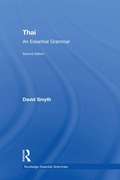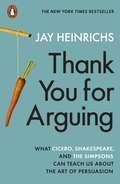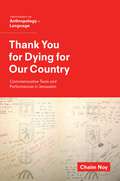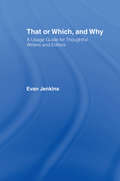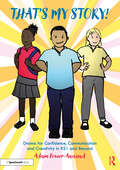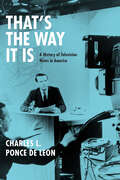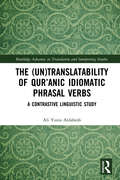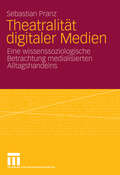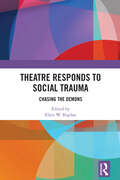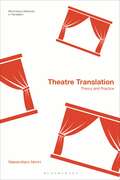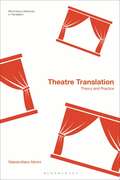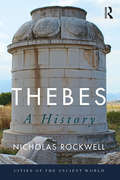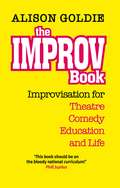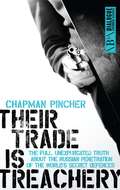- Table View
- List View
Thai: An Essential Grammar (Routledge Essential Grammars)
by David SmythThis second edition of Thai: An Essential Grammar provides an up-to-date and concise reference guide to Thai grammar. Using clear, jargon-free explanations, it sets out the complexities of Thai in short, readable sections and presents an accessible description of the language. Focus is kept on the real patterns of use today and grammar forms are demonstrated through a wide range of relevant examples. No prior knowledge is assumed on the part of the reader. Features include: Coverage of crucial topics, such as sentence particles, negation, questions and quantification Examples given in both Thai script and romanised transliteration Pronunciation section Guidance on speech conventions and the Thai writing system Glossary of grammatical terms Two appendices covering Romanisation systems and three key verbs Bibliography This unique reference work will prove invaluable to all learners looking to master the grammar of Thai. It is ideal either for independent study or for students in schools, colleges, universities and adult classes of all types.
Thank You for Arguing: What Cicero, Shakespeare and the Simpsons Can Teach Us About the Art of Persuasion
by Jay HeinrichsTHE NEW YORK TIMES BESTSELLERYour ultimate guide to the art of winning arguments, in a brand new editionEveryone is always trying to persuade us of something: politicians, advertising, the media, and most definitely our families. Thank You for Arguing is your master class in the art of persuasion, taught by professors ranging from Bart Simpson to Winston Churchill. With all the wisdom of the ages, from classical oratory to contemporary politics and pop-culture, Thank You For Arguing shows you how to win more than your fair share of arguments, as well as: >How to shine at work, avoid speeding tickets, and outwit argumentative partners >Cicero's secrets to moving an audience, Donald Trump's savvy speechmaking, the art of giving a TED talk>Tactics like Setting Your Goals, Making Them Like You, Gaining the High Ground>Defuse an angry accuser and benefit from your own mistakes>The art of rhetoric, from eloquence and friendship to wit and irrefutable logicWritten by one of today's most popular online language experts, Thank You For Arguing is brimming with time-tested rhetorical tips and persuasion techniques that will change your life. And that's not hyperbole.
THANK YOU FOR DYING FOR COUNTRY OSANTL C: Commemorative Texts and Performances in Jerusalem (Oxf Studies in Anthropology of Language)
by Chaim NoyCombining ethnographic, semiotic, and performative approaches, this book examines texts and accompanying acts of writing of national commemoration. The commemorative visitor book is viewed as a mobilized stage, a communication medium, where visitors' public performances are presented, and where acts of participation are authored and composed. The study contextualizes the visitor book within the material and ideological environment where it is positioned and where it functions. The semiotics of commemoration are mirrored in the visitor book, which functions as a participatory platform that becomes an extension of the commemorative spaces in the museum. The study addresses tourists' and visitors' texts, i.e. the commemorative entries in the book, which are succinct dialogical utterances. Through these public performances, individuals and groups of visitors align and affiliate with a larger imagined national community. Reading the entries allows a unique perspective on communication practices and processes, and vividly illustrates such concepts as genre, voice, addressivity, indexicality, and the very acts of writing and reading. The book's many entries tell stories of affirming, but also resisting the narrative tenets of Zionist national identity, and they illustrate the politics of gender and ethnicity in Israel society. The book presents many ethnographic observations and interviews, which were done both with the management of the site (Ammunition Hill National Memorial Site), and with the visitors themselves. The observations shed light on processes and practices involved in writing and reading, and on how visitors decide on what to write and how they collaborate on drafting their entries. The interviews with the site's management also illuminate the commemoration projects, and how museums and exhibitions are staged and managed.
Thank You for Dying for Our Country: Commemorative Texts and Performances in Jerusalem (Oxf Studies in Anthropology of Language)
by Chaim NoyCombining ethnographic, semiotic, and performative approaches, this book examines texts and accompanying acts of writing of national commemoration. The commemorative visitor book is viewed as a mobilized stage, a communication medium, where visitors' public performances are presented, and where acts of participation are authored and composed. The study contextualizes the visitor book within the material and ideological environment where it is positioned and where it functions. The semiotics of commemoration are mirrored in the visitor book, which functions as a participatory platform that becomes an extension of the commemorative spaces in the museum. The study addresses tourists' and visitors' texts, i.e. the commemorative entries in the book, which are succinct dialogical utterances. Through these public performances, individuals and groups of visitors align and affiliate with a larger imagined national community. Reading the entries allows a unique perspective on communication practices and processes, and vividly illustrates such concepts as genre, voice, addressivity, indexicality, and the very acts of writing and reading. The book's many entries tell stories of affirming, but also resisting the narrative tenets of Zionist national identity, and they illustrate the politics of gender and ethnicity in Israel society. The book presents many ethnographic observations and interviews, which were done both with the management of the site (Ammunition Hill National Memorial Site), and with the visitors themselves. The observations shed light on processes and practices involved in writing and reading, and on how visitors decide on what to write and how they collaborate on drafting their entries. The interviews with the site's management also illuminate the commemoration projects, and how museums and exhibitions are staged and managed.
That or Which, and Why: A Usage Guide for Thoughtful Writers and Editors
by Evan JenkinsThat or Which, and Why is an insightful and witty guide to writing. Based on Evan Jenkins's long-running column 'Language Corner' in Columbia Journalism Review, the book is compiled of brief, alphabetically arranged entries on approximately 200 major writing stumbling blocks, from the wonderful world of 'that' and 'which' to trickier terrain like the correct usage of common idiomatic expressions.Working from his experiences as a newsroom editor and teacher, Jenkins' humorous tone puts the reader at ease, unlike many of the writing and usage guides out there that are off-putting in their rigidity and dogmatism. He takes the 'we're-all-in-this-together' approach to teaching better writing - maintaining a light tone throughout the book and emphasizing flexibility and easy-to-use guidelines rather than delivering orders from Grammar-on-high.
That or Which, and Why: A Usage Guide for Thoughtful Writers and Editors
by Evan JenkinsThat or Which, and Why is an insightful and witty guide to writing. Based on Evan Jenkins's long-running column 'Language Corner' in Columbia Journalism Review, the book is compiled of brief, alphabetically arranged entries on approximately 200 major writing stumbling blocks, from the wonderful world of 'that' and 'which' to trickier terrain like the correct usage of common idiomatic expressions.Working from his experiences as a newsroom editor and teacher, Jenkins' humorous tone puts the reader at ease, unlike many of the writing and usage guides out there that are off-putting in their rigidity and dogmatism. He takes the 'we're-all-in-this-together' approach to teaching better writing - maintaining a light tone throughout the book and emphasizing flexibility and easy-to-use guidelines rather than delivering orders from Grammar-on-high.
That's My Story!: Drama for Confidence, Communication and Creativity in KS1 and Beyond
by Adam Power-AnnandThe ability to communicate is an essential life skill for all children and young people and it underpins their social, emotional and educational development. If a child experiences a positive relationship with an adult listening carefully, they are more likely to constructively share their thoughts, feelings and their imaginative ideas.That’s My Story! places children’s imagined stories at the heart of their own development and provides a joyful, creative approach to support young children’s personal and social development and to encourage their communication. In this book you will find: Tried-and-tested drama games and activities that support communication and well-being, all adaptable to complement your current practice Guidance and advice on how to promote positive adult-child interactions Examples of creative interventions that support children’s communication development A celebration of the joy that comes with carefully listening to children’s own imagined stories Those of us who work with children can sense a tangible connection between how young children feel and how they communicate. This essential and practical resource will be valuable reading for primary teachers, teaching assistants, speech and language therapists, and drama practitioners, as well as outreach and education departments of theatre companies and other arts organisations.
That's My Story!: Drama for Confidence, Communication and Creativity in KS1 and Beyond
by Adam Power-AnnandThe ability to communicate is an essential life skill for all children and young people and it underpins their social, emotional and educational development. If a child experiences a positive relationship with an adult listening carefully, they are more likely to constructively share their thoughts, feelings and their imaginative ideas.That’s My Story! places children’s imagined stories at the heart of their own development and provides a joyful, creative approach to support young children’s personal and social development and to encourage their communication. In this book you will find: Tried-and-tested drama games and activities that support communication and well-being, all adaptable to complement your current practice Guidance and advice on how to promote positive adult-child interactions Examples of creative interventions that support children’s communication development A celebration of the joy that comes with carefully listening to children’s own imagined stories Those of us who work with children can sense a tangible connection between how young children feel and how they communicate. This essential and practical resource will be valuable reading for primary teachers, teaching assistants, speech and language therapists, and drama practitioners, as well as outreach and education departments of theatre companies and other arts organisations.
That's the Way It Is: A History of Television News in America
by Charles L. Ponce de LeonWhen critics decry the current state of our public discourse, one reliably easy target is television news. It’s too dumbed-down, they say; it’s no longer news but entertainment, celebrity-obsessed and vapid. The critics may be right. But, as Charles L. Ponce de Leon explains in That’s the Way It Is, TV news has always walked a fine line between hard news and fluff. The familiar story of decline fails to acknowledge real changes in the media and Americans’ news-consuming habits, while also harking back to a golden age that, on closer examination, is revealed to be not so golden after all. Ponce de Leon traces the entire history of televised news, from the household names of the late 1940s and early ’50s, like Eric Sevareid, Edward R. Murrow, and Walter Cronkite, through the rise of cable, the political power of Fox News, and the satirical punch of Colbert and Stewart. He shows us an industry forever in transition, where newsmagazines and celebrity profiles vie with political news and serious investigations. The need for ratings success—and the lighter, human interest stories that can help bring it—Ponce de Leon makes clear, has always sat uneasily alongside a real desire to report hard news. Highlighting the contradictions and paradoxes at the heart of TV news, and telling a story rich in familiar figures and fascinating anecdotes, That’s the Way It Is will be the definitive account of how television has showed us our history as it happens.
That's the Way It Is: A History of Television News in America
by Charles L. Ponce de LeonWhen critics decry the current state of our public discourse, one reliably easy target is television news. It’s too dumbed-down, they say; it’s no longer news but entertainment, celebrity-obsessed and vapid. The critics may be right. But, as Charles L. Ponce de Leon explains in That’s the Way It Is, TV news has always walked a fine line between hard news and fluff. The familiar story of decline fails to acknowledge real changes in the media and Americans’ news-consuming habits, while also harking back to a golden age that, on closer examination, is revealed to be not so golden after all. Ponce de Leon traces the entire history of televised news, from the household names of the late 1940s and early ’50s, like Eric Sevareid, Edward R. Murrow, and Walter Cronkite, through the rise of cable, the political power of Fox News, and the satirical punch of Colbert and Stewart. He shows us an industry forever in transition, where newsmagazines and celebrity profiles vie with political news and serious investigations. The need for ratings success—and the lighter, human interest stories that can help bring it—Ponce de Leon makes clear, has always sat uneasily alongside a real desire to report hard news. Highlighting the contradictions and paradoxes at the heart of TV news, and telling a story rich in familiar figures and fascinating anecdotes, That’s the Way It Is will be the definitive account of how television has showed us our history as it happens.
That's the Way It Is: A History of Television News in America
by Charles L. Ponce de LeonWhen critics decry the current state of our public discourse, one reliably easy target is television news. It’s too dumbed-down, they say; it’s no longer news but entertainment, celebrity-obsessed and vapid. The critics may be right. But, as Charles L. Ponce de Leon explains in That’s the Way It Is, TV news has always walked a fine line between hard news and fluff. The familiar story of decline fails to acknowledge real changes in the media and Americans’ news-consuming habits, while also harking back to a golden age that, on closer examination, is revealed to be not so golden after all. Ponce de Leon traces the entire history of televised news, from the household names of the late 1940s and early ’50s, like Eric Sevareid, Edward R. Murrow, and Walter Cronkite, through the rise of cable, the political power of Fox News, and the satirical punch of Colbert and Stewart. He shows us an industry forever in transition, where newsmagazines and celebrity profiles vie with political news and serious investigations. The need for ratings success—and the lighter, human interest stories that can help bring it—Ponce de Leon makes clear, has always sat uneasily alongside a real desire to report hard news. Highlighting the contradictions and paradoxes at the heart of TV news, and telling a story rich in familiar figures and fascinating anecdotes, That’s the Way It Is will be the definitive account of how television has showed us our history as it happens.
That's the Way It Is: A History of Television News in America
by Charles L. Ponce de LeonWhen critics decry the current state of our public discourse, one reliably easy target is television news. It’s too dumbed-down, they say; it’s no longer news but entertainment, celebrity-obsessed and vapid. The critics may be right. But, as Charles L. Ponce de Leon explains in That’s the Way It Is, TV news has always walked a fine line between hard news and fluff. The familiar story of decline fails to acknowledge real changes in the media and Americans’ news-consuming habits, while also harking back to a golden age that, on closer examination, is revealed to be not so golden after all. Ponce de Leon traces the entire history of televised news, from the household names of the late 1940s and early ’50s, like Eric Sevareid, Edward R. Murrow, and Walter Cronkite, through the rise of cable, the political power of Fox News, and the satirical punch of Colbert and Stewart. He shows us an industry forever in transition, where newsmagazines and celebrity profiles vie with political news and serious investigations. The need for ratings success—and the lighter, human interest stories that can help bring it—Ponce de Leon makes clear, has always sat uneasily alongside a real desire to report hard news. Highlighting the contradictions and paradoxes at the heart of TV news, and telling a story rich in familiar figures and fascinating anecdotes, That’s the Way It Is will be the definitive account of how television has showed us our history as it happens.
That's the Way It Is: A History of Television News in America
by Charles L. Ponce de LeonWhen critics decry the current state of our public discourse, one reliably easy target is television news. It’s too dumbed-down, they say; it’s no longer news but entertainment, celebrity-obsessed and vapid. The critics may be right. But, as Charles L. Ponce de Leon explains in That’s the Way It Is, TV news has always walked a fine line between hard news and fluff. The familiar story of decline fails to acknowledge real changes in the media and Americans’ news-consuming habits, while also harking back to a golden age that, on closer examination, is revealed to be not so golden after all. Ponce de Leon traces the entire history of televised news, from the household names of the late 1940s and early ’50s, like Eric Sevareid, Edward R. Murrow, and Walter Cronkite, through the rise of cable, the political power of Fox News, and the satirical punch of Colbert and Stewart. He shows us an industry forever in transition, where newsmagazines and celebrity profiles vie with political news and serious investigations. The need for ratings success—and the lighter, human interest stories that can help bring it—Ponce de Leon makes clear, has always sat uneasily alongside a real desire to report hard news. Highlighting the contradictions and paradoxes at the heart of TV news, and telling a story rich in familiar figures and fascinating anecdotes, That’s the Way It Is will be the definitive account of how television has showed us our history as it happens.
That's the Way It Is: A History of Television News in America
by Charles L. Ponce de LeonWhen critics decry the current state of our public discourse, one reliably easy target is television news. It’s too dumbed-down, they say; it’s no longer news but entertainment, celebrity-obsessed and vapid. The critics may be right. But, as Charles L. Ponce de Leon explains in That’s the Way It Is, TV news has always walked a fine line between hard news and fluff. The familiar story of decline fails to acknowledge real changes in the media and Americans’ news-consuming habits, while also harking back to a golden age that, on closer examination, is revealed to be not so golden after all. Ponce de Leon traces the entire history of televised news, from the household names of the late 1940s and early ’50s, like Eric Sevareid, Edward R. Murrow, and Walter Cronkite, through the rise of cable, the political power of Fox News, and the satirical punch of Colbert and Stewart. He shows us an industry forever in transition, where newsmagazines and celebrity profiles vie with political news and serious investigations. The need for ratings success—and the lighter, human interest stories that can help bring it—Ponce de Leon makes clear, has always sat uneasily alongside a real desire to report hard news. Highlighting the contradictions and paradoxes at the heart of TV news, and telling a story rich in familiar figures and fascinating anecdotes, That’s the Way It Is will be the definitive account of how television has showed us our history as it happens.
The: A Contrastive Linguistic Study (Routledge Advances in Translation and Interpreting Studies)
by Ali Yunis AldaheshQur’anic idiomaticity, in its all aspects, poses a great deal of challenge to Qur’an readers, learners, commentators, and translators. One of the most challenging aspects of Qur’anic idiomaticity is Qur’anic idiomatic phrasal verbs, where significances of proper Arabic verbs are entirely fused with significances of prepositions following them to produce new significances that have nothing to do with the basic significances of those verbs and prepositions. By examining a corpus of ten of the most influential English translations of the Qur’an, this study scrutinizes how some translators of the Qur’an have dealt with the phenomenon of Qur’anic idiomatic phrasal verbs, the difficulties that they have encountered when translating them into English, and the strategies that they have employed in their attempts to overcome the inherent ambiguity of such expressions and provide their functional-pragmatic equivalents for English readership. The study proposes a working model for analysing and assessing the translation of the Qur’anic idiomatic phrasal verbs and provides a number of theory-based recommendations for translators in general and Qur’an translators in particular.
The: A Contrastive Linguistic Study (Routledge Advances in Translation and Interpreting Studies)
by Ali Yunis AldaheshQur’anic idiomaticity, in its all aspects, poses a great deal of challenge to Qur’an readers, learners, commentators, and translators. One of the most challenging aspects of Qur’anic idiomaticity is Qur’anic idiomatic phrasal verbs, where significances of proper Arabic verbs are entirely fused with significances of prepositions following them to produce new significances that have nothing to do with the basic significances of those verbs and prepositions. By examining a corpus of ten of the most influential English translations of the Qur’an, this study scrutinizes how some translators of the Qur’an have dealt with the phenomenon of Qur’anic idiomatic phrasal verbs, the difficulties that they have encountered when translating them into English, and the strategies that they have employed in their attempts to overcome the inherent ambiguity of such expressions and provide their functional-pragmatic equivalents for English readership. The study proposes a working model for analysing and assessing the translation of the Qur’anic idiomatic phrasal verbs and provides a number of theory-based recommendations for translators in general and Qur’an translators in particular.
Theatralität digitaler Medien: Eine wissenssoziologische Betrachtung medialisierten Alltagshandelns
by Sebastian PranzTheatre Responds to Social Trauma: Chasing the Demons (Routledge Series in Equity, Diversity, and Inclusion in Theatre and Performance)
by Ellen W. KaplanThis book is a collection of chapters by playwrights, directors, devisers, scholars, and educators whose praxis involves representing, theorizing, and performing social trauma.Chapters explore how psychic catastrophes and ruptures are often embedded in social systems of oppression and forged in zones of conflict within and across national borders. Through multiple lenses and diverse approaches, the authors examine the connections between collective trauma, social identity, and personal struggle. We look at the generational transmission of trauma, socially induced pathologies, and societal re-inscriptions of trauma, from mass incarceration to war-induced psychoses, from gendered violence through racist practices. Collective trauma may shape, protect, and preserve group identity, promoting a sense of cohesion and meaning, even as it shakes individuals through pain. Engaging with communities under significant stress through artistic practice offers a path towards reconstructing the meaning(s) of social trauma, making sense of the past, understanding the present, and re-visioning the future.The chapters combine theoretical and practical work, exploring the conceptual foundations and the artists’ processes as they interrogate the intersections of personal grief and communal mourning, through drama, poetry, and embodied performance.
Theatre Responds to Social Trauma: Chasing the Demons (Routledge Series in Equity, Diversity, and Inclusion in Theatre and Performance)
This book is a collection of chapters by playwrights, directors, devisers, scholars, and educators whose praxis involves representing, theorizing, and performing social trauma.Chapters explore how psychic catastrophes and ruptures are often embedded in social systems of oppression and forged in zones of conflict within and across national borders. Through multiple lenses and diverse approaches, the authors examine the connections between collective trauma, social identity, and personal struggle. We look at the generational transmission of trauma, socially induced pathologies, and societal re-inscriptions of trauma, from mass incarceration to war-induced psychoses, from gendered violence through racist practices. Collective trauma may shape, protect, and preserve group identity, promoting a sense of cohesion and meaning, even as it shakes individuals through pain. Engaging with communities under significant stress through artistic practice offers a path towards reconstructing the meaning(s) of social trauma, making sense of the past, understanding the present, and re-visioning the future.The chapters combine theoretical and practical work, exploring the conceptual foundations and the artists’ processes as they interrogate the intersections of personal grief and communal mourning, through drama, poetry, and embodied performance.
Theatre Translation: Theory and Practice (Bloomsbury Advances in Translation)
by Massimiliano MoriniTranslation for the theatre is often considered to hold a marginal status between literary translation and adaptation for the stage. As a result, this book argues that studies of this complex activity tend to take either a textual or performative approach. After exploring the history of translation theory through these lenses, Massimiliano Morini proposes a more totalizing view of 'theatre translation' as the sum of operations required to transform one theatre act into another, and analyses three complex Western case histories in light of this all-encompassing definition. Combining theory with practice, Morini investigates how traditional ideas on translation – from Plautus and Cicero to the early 20th century – have been applied in the theatrical domain. He then compares and contrasts the inherently textual viewpoint of post-humanistic translators with the more performative approaches of contemporary theatrical practitioners, and chronicles the rise of performative views in the third millennium. Positioning itself at the intersection of past and present, as well as translation studies and theatre semiotics, Theatre Translation provides a full diachronic survey of an age-old activity and a burgeoning academic field.
Theatre Translation: Theory and Practice (Bloomsbury Advances in Translation)
by Massimiliano MoriniTranslation for the theatre is often considered to hold a marginal status between literary translation and adaptation for the stage. As a result, this book argues that studies of this complex activity tend to take either a textual or performative approach. After exploring the history of translation theory through these lenses, Massimiliano Morini proposes a more totalizing view of 'theatre translation' as the sum of operations required to transform one theatre act into another, and analyses three complex Western case histories in light of this all-encompassing definition. Combining theory with practice, Morini investigates how traditional ideas on translation – from Plautus and Cicero to the early 20th century – have been applied in the theatrical domain. He then compares and contrasts the inherently textual viewpoint of post-humanistic translators with the more performative approaches of contemporary theatrical practitioners, and chronicles the rise of performative views in the third millennium. Positioning itself at the intersection of past and present, as well as translation studies and theatre semiotics, Theatre Translation provides a full diachronic survey of an age-old activity and a burgeoning academic field.
Thebes: A History (Cities of the Ancient World)
by Nicholas RockwellThebes offers a scholarly survey of the history and archaeology of the city, from 1600 BCE – 476 CE. Discussions of major developments in politics, war, society and culture form the basis of a chronological examination of one of Greece’s most powerful and dynamic cities. By taking a broad view, the book’s account speaks to larger trends in the ancient Mediterranean world while also demonstrating how Thebes was unique in its ancient context. It provides an up-to-date examination of all available information: topographic, demographic, numismatic, epigraphic, archaeological and textual discussions provide the most complete, current picture of ancient Thebes and illustrate the value of an interdisciplinary approach.
Thebes: A History (Cities of the Ancient World)
by Nicholas RockwellThebes offers a scholarly survey of the history and archaeology of the city, from 1600 BCE – 476 CE. Discussions of major developments in politics, war, society and culture form the basis of a chronological examination of one of Greece’s most powerful and dynamic cities. By taking a broad view, the book’s account speaks to larger trends in the ancient Mediterranean world while also demonstrating how Thebes was unique in its ancient context. It provides an up-to-date examination of all available information: topographic, demographic, numismatic, epigraphic, archaeological and textual discussions provide the most complete, current picture of ancient Thebes and illustrate the value of an interdisciplinary approach.
The Improv Book: Improvisation for Theatre, Comedy, Education and Life (The Actor's Toolkit)
by Alison GoldieA smart, witty and accessible guide to the rewarding and joyful practice of improvisation. • Classic improv games and variations • Telling stories and creating characters • Using improv to make theatre and comedy, from monologues to full-scale productions An asset to students and teachers of improvisation in schools, drama schools, higher education and theatre groups, both professional and amateur. It will also be of benefit to organisations and individual readers who want to discover how improv stimulates creativity and confidence in all areas of life. The Improv Book opens up this exciting discipline to a wider audience.
Their Trade is Treachery: The full, unexpurgated truth about the Russian penetration of the world's secret defences (Dialogue Espionage Classics Ser.)
by Harry Champan PincherHarry Chapman Pincher is regarded as one of the finest investigative reporters of the twentieth century. Over the course of a glittering six-decade career, he became notorious as a relentless investigator of spies and their secret trade, proving to be a constant thorn in the side of the establishment. So influential was he that Prime Minister Harold Macmillan once asked, 'Can nothing be done to suppress Mr Chapman Pincher?' It is for his sensational 1981 book, Their Trade is Treachery, that he is perhaps best known. In this extraordinary volume he dissected the Soviet Union's inflitration of the western world and helped unmask the Cambridge Five. He also outlined his suspicions that former MI5 chief Roger Hollis was in fact a super spy at the heart of a ring of double agents poisoning the secret intelligence service from within. However, the Hollis revelation was just one of the book's many astounding coups. Its impact at the time was immense and highly controversial, sending ripples through the British intelligence and political landscapes. Never before had any writer penetrated so deeply and authoritatively into this world - and few have since. Available now for the first time in thirty years, this eye-opening volume is an incomparable and definitive account of the thrilling nature of Cold War espionage and treachery. The Dialogue Espionage Classics series began in 2010 with the purpose of bringing back classic out-of-print spy stories that should never be forgotten. From the Great War to the Cold War, from the French Resistance to the Cambridge Five, from Special Operations to Bletchley Park, this fascinating spy history series includes some of the best military, espionage and adventure stories ever told.
